HNC Computing, Unit 9: Software Development Lifecycle Report
VerifiedAdded on 2023/03/17
|18
|3745
|95
Report
AI Summary
This report provides a detailed overview of Software Development Lifecycles (SDLC). It begins by describing two iterative models (Spiral and DSDM) and two sequential models (Waterfall and V-model), detailing their benefits, drawbacks, and suitability for different project types. The report then explores risk management within the Spiral model, outlining the process and sources of risk. Furthermore, it discusses the importance of feasibility reports in the project lifecycle. The assignment fulfills the requirements of the HNC in Computing Unit 9: Software Development Lifecycles and provides valuable resources for training new software development staff by producing some resources which the new recruits can study to help them understand software development lifecycles in relation to their roles within the organisation.
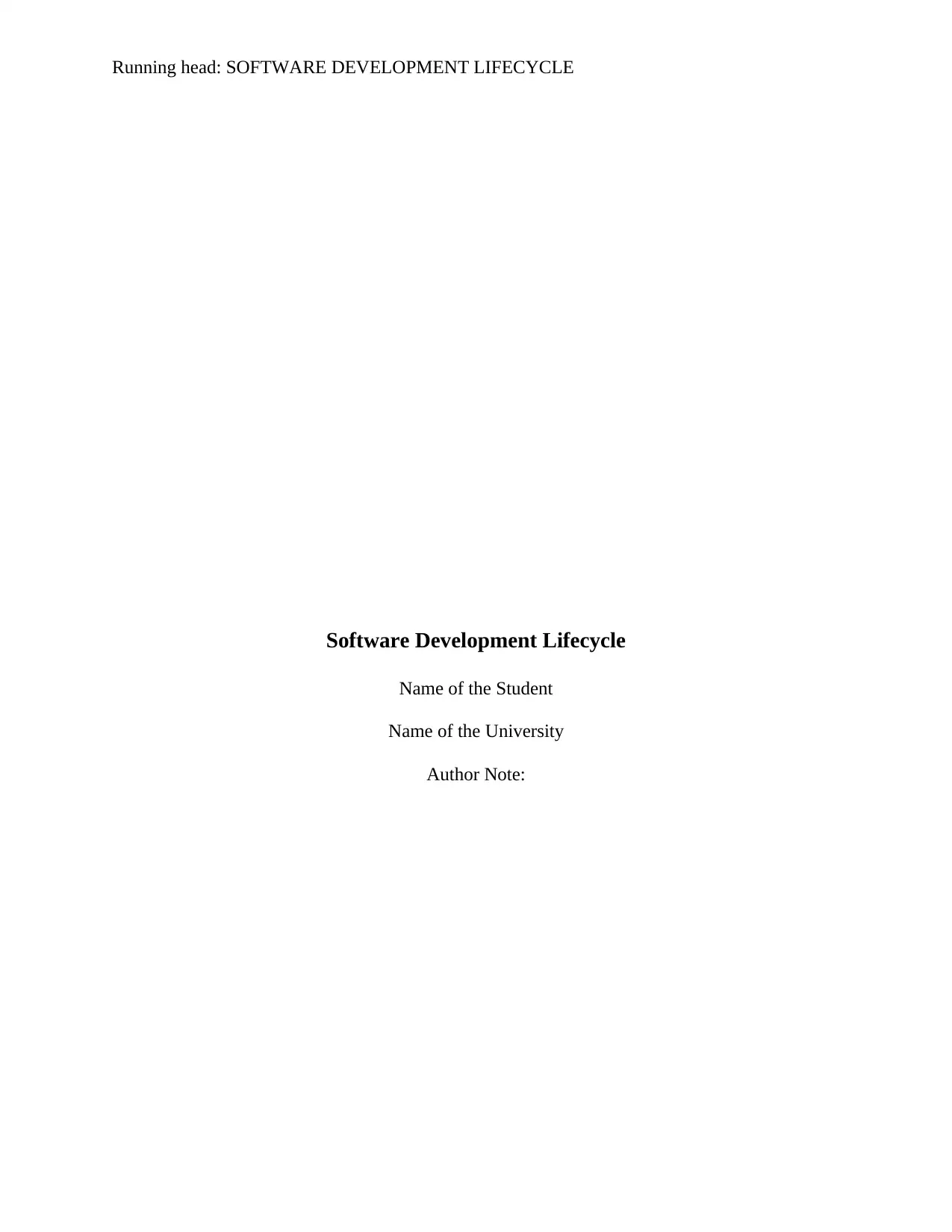
Running head: SOFTWARE DEVELOPMENT LIFECYCLE
Software Development Lifecycle
Name of the Student
Name of the University
Author Note:
Software Development Lifecycle
Name of the Student
Name of the University
Author Note:
Paraphrase This Document
Need a fresh take? Get an instant paraphrase of this document with our AI Paraphraser
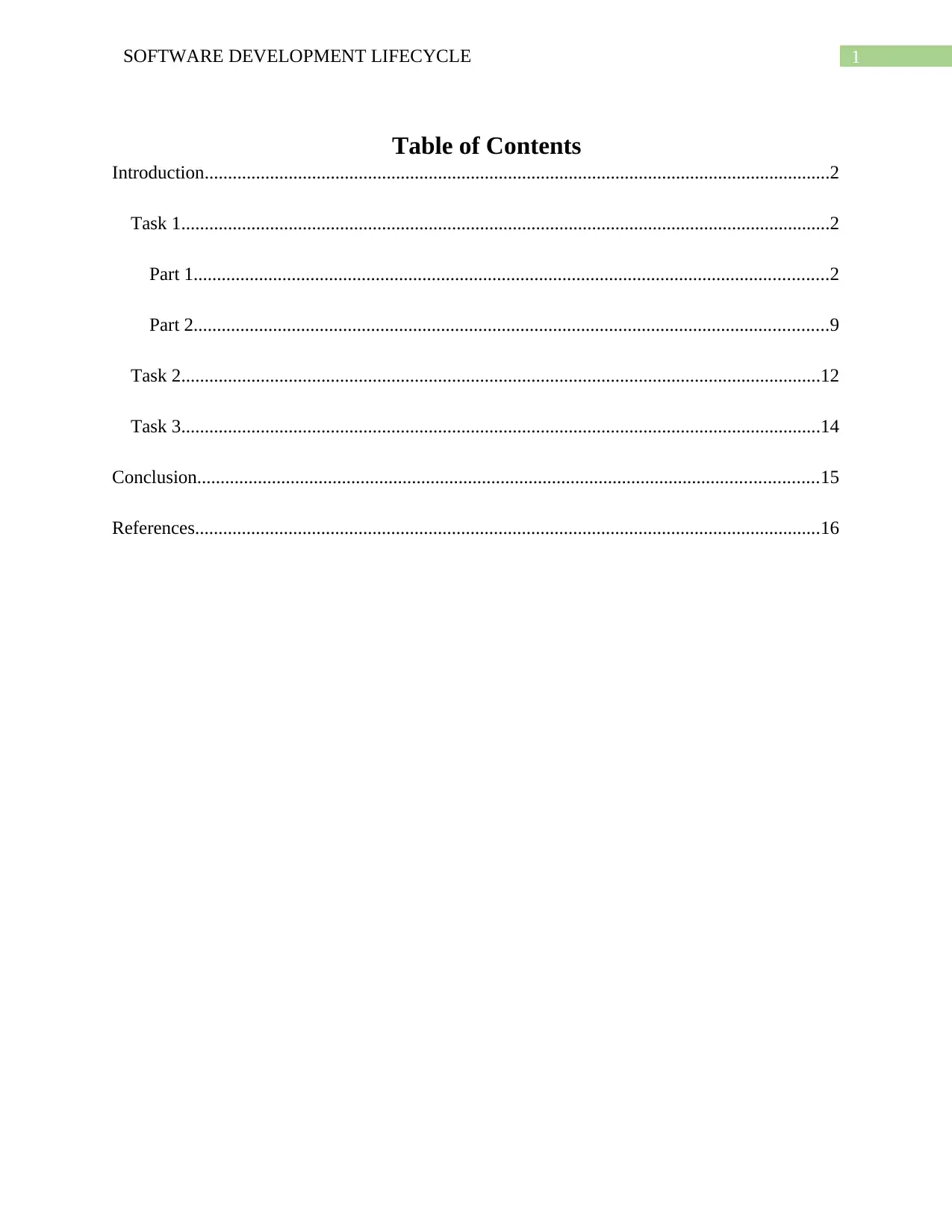
1SOFTWARE DEVELOPMENT LIFECYCLE
Table of Contents
Introduction......................................................................................................................................2
Task 1...........................................................................................................................................2
Part 1........................................................................................................................................2
Part 2........................................................................................................................................9
Task 2.........................................................................................................................................12
Task 3.........................................................................................................................................14
Conclusion.....................................................................................................................................15
References......................................................................................................................................16
Table of Contents
Introduction......................................................................................................................................2
Task 1...........................................................................................................................................2
Part 1........................................................................................................................................2
Part 2........................................................................................................................................9
Task 2.........................................................................................................................................12
Task 3.........................................................................................................................................14
Conclusion.....................................................................................................................................15
References......................................................................................................................................16
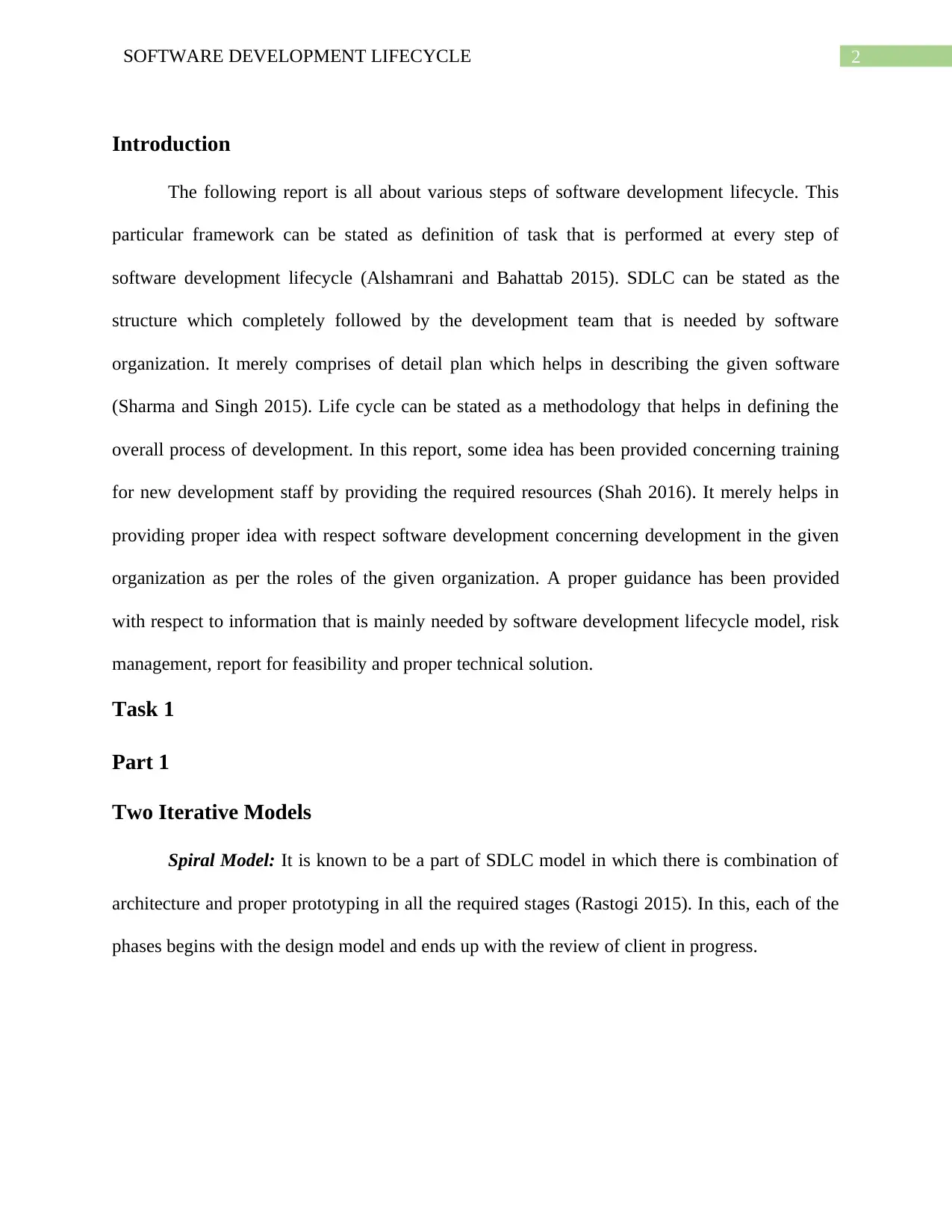
2SOFTWARE DEVELOPMENT LIFECYCLE
Introduction
The following report is all about various steps of software development lifecycle. This
particular framework can be stated as definition of task that is performed at every step of
software development lifecycle (Alshamrani and Bahattab 2015). SDLC can be stated as the
structure which completely followed by the development team that is needed by software
organization. It merely comprises of detail plan which helps in describing the given software
(Sharma and Singh 2015). Life cycle can be stated as a methodology that helps in defining the
overall process of development. In this report, some idea has been provided concerning training
for new development staff by providing the required resources (Shah 2016). It merely helps in
providing proper idea with respect software development concerning development in the given
organization as per the roles of the given organization. A proper guidance has been provided
with respect to information that is mainly needed by software development lifecycle model, risk
management, report for feasibility and proper technical solution.
Task 1
Part 1
Two Iterative Models
Spiral Model: It is known to be a part of SDLC model in which there is combination of
architecture and proper prototyping in all the required stages (Rastogi 2015). In this, each of the
phases begins with the design model and ends up with the review of client in progress.
Introduction
The following report is all about various steps of software development lifecycle. This
particular framework can be stated as definition of task that is performed at every step of
software development lifecycle (Alshamrani and Bahattab 2015). SDLC can be stated as the
structure which completely followed by the development team that is needed by software
organization. It merely comprises of detail plan which helps in describing the given software
(Sharma and Singh 2015). Life cycle can be stated as a methodology that helps in defining the
overall process of development. In this report, some idea has been provided concerning training
for new development staff by providing the required resources (Shah 2016). It merely helps in
providing proper idea with respect software development concerning development in the given
organization as per the roles of the given organization. A proper guidance has been provided
with respect to information that is mainly needed by software development lifecycle model, risk
management, report for feasibility and proper technical solution.
Task 1
Part 1
Two Iterative Models
Spiral Model: It is known to be a part of SDLC model in which there is combination of
architecture and proper prototyping in all the required stages (Rastogi 2015). In this, each of the
phases begins with the design model and ends up with the review of client in progress.
⊘ This is a preview!⊘
Do you want full access?
Subscribe today to unlock all pages.

Trusted by 1+ million students worldwide
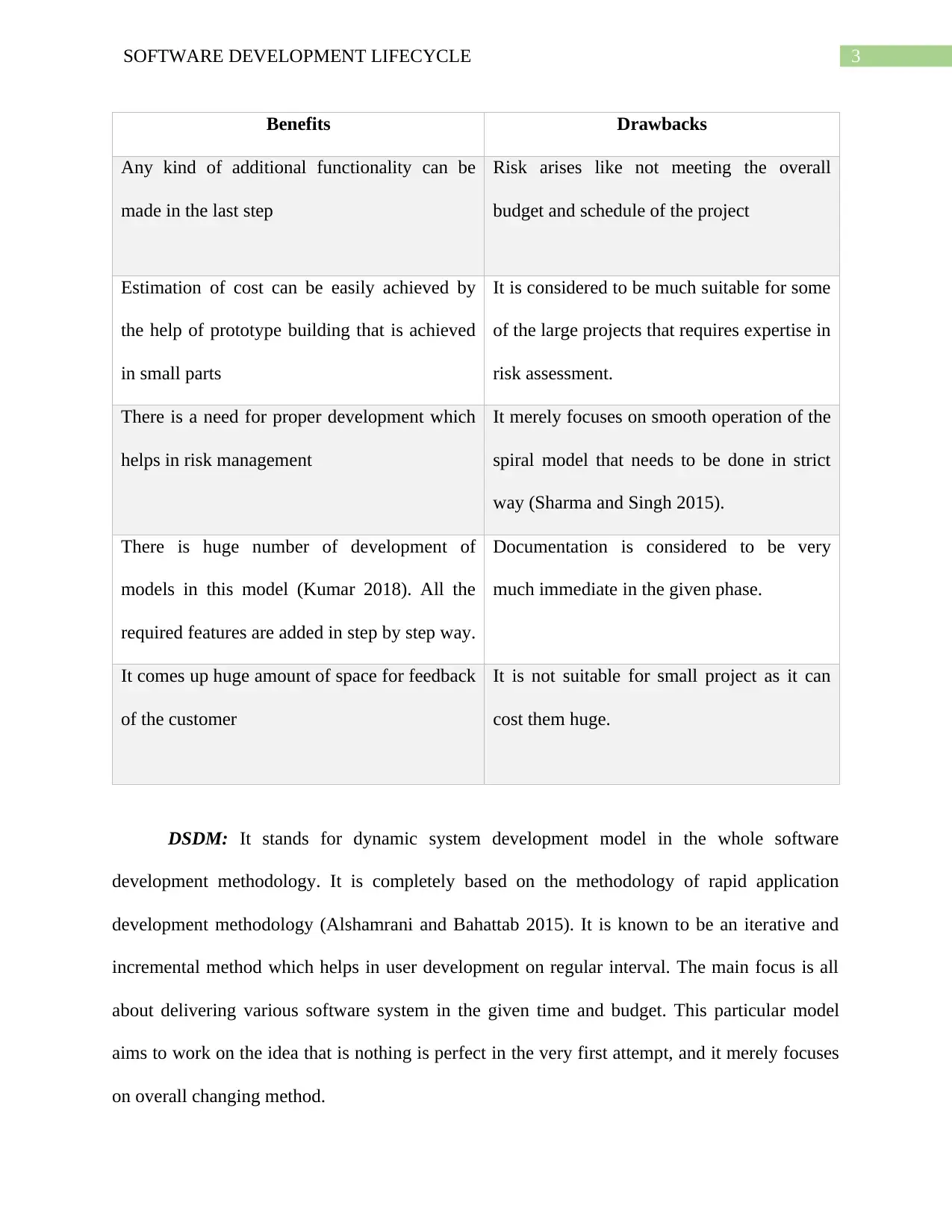
3SOFTWARE DEVELOPMENT LIFECYCLE
Benefits Drawbacks
Any kind of additional functionality can be
made in the last step
Risk arises like not meeting the overall
budget and schedule of the project
Estimation of cost can be easily achieved by
the help of prototype building that is achieved
in small parts
It is considered to be much suitable for some
of the large projects that requires expertise in
risk assessment.
There is a need for proper development which
helps in risk management
It merely focuses on smooth operation of the
spiral model that needs to be done in strict
way (Sharma and Singh 2015).
There is huge number of development of
models in this model (Kumar 2018). All the
required features are added in step by step way.
Documentation is considered to be very
much immediate in the given phase.
It comes up huge amount of space for feedback
of the customer
It is not suitable for small project as it can
cost them huge.
DSDM: It stands for dynamic system development model in the whole software
development methodology. It is completely based on the methodology of rapid application
development methodology (Alshamrani and Bahattab 2015). It is known to be an iterative and
incremental method which helps in user development on regular interval. The main focus is all
about delivering various software system in the given time and budget. This particular model
aims to work on the idea that is nothing is perfect in the very first attempt, and it merely focuses
on overall changing method.
Benefits Drawbacks
Any kind of additional functionality can be
made in the last step
Risk arises like not meeting the overall
budget and schedule of the project
Estimation of cost can be easily achieved by
the help of prototype building that is achieved
in small parts
It is considered to be much suitable for some
of the large projects that requires expertise in
risk assessment.
There is a need for proper development which
helps in risk management
It merely focuses on smooth operation of the
spiral model that needs to be done in strict
way (Sharma and Singh 2015).
There is huge number of development of
models in this model (Kumar 2018). All the
required features are added in step by step way.
Documentation is considered to be very
much immediate in the given phase.
It comes up huge amount of space for feedback
of the customer
It is not suitable for small project as it can
cost them huge.
DSDM: It stands for dynamic system development model in the whole software
development methodology. It is completely based on the methodology of rapid application
development methodology (Alshamrani and Bahattab 2015). It is known to be an iterative and
incremental method which helps in user development on regular interval. The main focus is all
about delivering various software system in the given time and budget. This particular model
aims to work on the idea that is nothing is perfect in the very first attempt, and it merely focuses
on overall changing method.
Paraphrase This Document
Need a fresh take? Get an instant paraphrase of this document with our AI Paraphraser
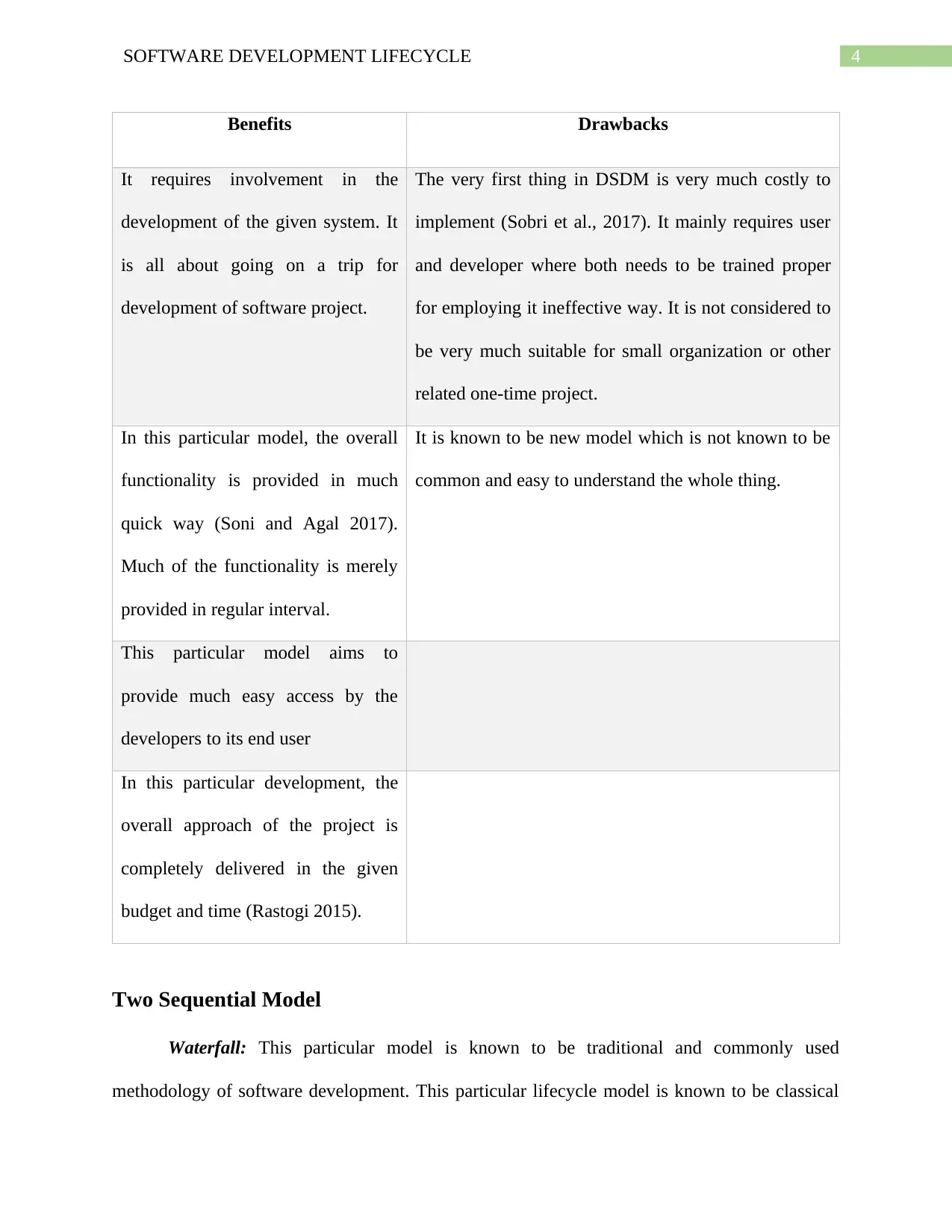
4SOFTWARE DEVELOPMENT LIFECYCLE
Benefits Drawbacks
It requires involvement in the
development of the given system. It
is all about going on a trip for
development of software project.
The very first thing in DSDM is very much costly to
implement (Sobri et al., 2017). It mainly requires user
and developer where both needs to be trained proper
for employing it ineffective way. It is not considered to
be very much suitable for small organization or other
related one-time project.
In this particular model, the overall
functionality is provided in much
quick way (Soni and Agal 2017).
Much of the functionality is merely
provided in regular interval.
It is known to be new model which is not known to be
common and easy to understand the whole thing.
This particular model aims to
provide much easy access by the
developers to its end user
In this particular development, the
overall approach of the project is
completely delivered in the given
budget and time (Rastogi 2015).
Two Sequential Model
Waterfall: This particular model is known to be traditional and commonly used
methodology of software development. This particular lifecycle model is known to be classical
Benefits Drawbacks
It requires involvement in the
development of the given system. It
is all about going on a trip for
development of software project.
The very first thing in DSDM is very much costly to
implement (Sobri et al., 2017). It mainly requires user
and developer where both needs to be trained proper
for employing it ineffective way. It is not considered to
be very much suitable for small organization or other
related one-time project.
In this particular model, the overall
functionality is provided in much
quick way (Soni and Agal 2017).
Much of the functionality is merely
provided in regular interval.
It is known to be new model which is not known to be
common and easy to understand the whole thing.
This particular model aims to
provide much easy access by the
developers to its end user
In this particular development, the
overall approach of the project is
completely delivered in the given
budget and time (Rastogi 2015).
Two Sequential Model
Waterfall: This particular model is known to be traditional and commonly used
methodology of software development. This particular lifecycle model is known to be classical

5SOFTWARE DEVELOPMENT LIFECYCLE
one in the process of software development (Kumar 2018). This mere model aims in software
development where the given process is considered to be linear sequential flow. In this, any
phase of software development process is known to be sequential flow. It merely focuses on the
fact that software development process in linear sequential flow is known to be any part of
development process (Aljawarneh, Alawneh and Jaradat 2017). It mainly comes into picture
when the earlier phase is completed. The overall development is not defined in the process so
that the whole can go to earlier step. As a result, it becomes very much tough to easily make
changes in the requirements.
Benefits Drawbacks
Waterfall model is known to very much
easy and simple (Jindal 2016). It merely
makes use of methods, which is very
much beneficial for the start-up
developers.
This particular model mainly comes into picture
when there is precise upfront requirement model
are completely available.
It is very convenient to manage just
because of the overall rigidity of the
model (Tsui, Davis and Sahlin 2018).
Each of the phases come up with own
deliverables and own process of review
This particular model is not needed for
maintaining type project
In this particular stage, various processes
are completed in the given time. It merely
saves huge amount of time.
The biggest drawbacks of this method are that
application is merely found in the testing phase. It
is not possible for going back and editing
something.
one in the process of software development (Kumar 2018). This mere model aims in software
development where the given process is considered to be linear sequential flow. In this, any
phase of software development process is known to be sequential flow. It merely focuses on the
fact that software development process in linear sequential flow is known to be any part of
development process (Aljawarneh, Alawneh and Jaradat 2017). It mainly comes into picture
when the earlier phase is completed. The overall development is not defined in the process so
that the whole can go to earlier step. As a result, it becomes very much tough to easily make
changes in the requirements.
Benefits Drawbacks
Waterfall model is known to very much
easy and simple (Jindal 2016). It merely
makes use of methods, which is very
much beneficial for the start-up
developers.
This particular model mainly comes into picture
when there is precise upfront requirement model
are completely available.
It is very convenient to manage just
because of the overall rigidity of the
model (Tsui, Davis and Sahlin 2018).
Each of the phases come up with own
deliverables and own process of review
This particular model is not needed for
maintaining type project
In this particular stage, various processes
are completed in the given time. It merely
saves huge amount of time.
The biggest drawbacks of this method are that
application is merely found in the testing phase. It
is not possible for going back and editing
something.
⊘ This is a preview!⊘
Do you want full access?
Subscribe today to unlock all pages.

Trusted by 1+ million students worldwide

6SOFTWARE DEVELOPMENT LIFECYCLE
This particular model works very much
effective in some of the smaller project
(Nazir and Nazir 2018). It is mainly
needed for understanding the overall
requirement that needs to be understood
properly.
It comes up with the possibility of producing any
given software until and unless it reaches the last
stage of cycle development. In the given model,
there is no kind of option for understanding the
result of the project.
The overall process of testing is very
much easier as it can be done by the
reference in the given scene in the
beginning function specification
This particular model is most suitable for small
projects but is not considered to be suitable for
long and ongoing project (Roy, Dasgupta and
Chaki 2016). It is not ideal for projects where the
given requirements vary where it has option of
scope and modification.
V model: This particular model is considered to be very much suitable in every phase of
software development lifecycle (Roy, Dasgupta and Chaki 2016). This particular model helps in
determining every phase of software development. It mainly tends to ensure that every stage is
completely attached testing. A list of function is performed under this model like
It merely focuses that the testing takes place every stage of software development. It does
not occur only the coding is completed.
It merely focuses on the fact software development method tends to place with the
organization.
It merely highlights all the required software products are mainly created in the software
project.
This particular model works very much
effective in some of the smaller project
(Nazir and Nazir 2018). It is mainly
needed for understanding the overall
requirement that needs to be understood
properly.
It comes up with the possibility of producing any
given software until and unless it reaches the last
stage of cycle development. In the given model,
there is no kind of option for understanding the
result of the project.
The overall process of testing is very
much easier as it can be done by the
reference in the given scene in the
beginning function specification
This particular model is most suitable for small
projects but is not considered to be suitable for
long and ongoing project (Roy, Dasgupta and
Chaki 2016). It is not ideal for projects where the
given requirements vary where it has option of
scope and modification.
V model: This particular model is considered to be very much suitable in every phase of
software development lifecycle (Roy, Dasgupta and Chaki 2016). This particular model helps in
determining every phase of software development. It mainly tends to ensure that every stage is
completely attached testing. A list of function is performed under this model like
It merely focuses that the testing takes place every stage of software development. It does
not occur only the coding is completed.
It merely focuses on the fact software development method tends to place with the
organization.
It merely highlights all the required software products are mainly created in the software
project.
Paraphrase This Document
Need a fresh take? Get an instant paraphrase of this document with our AI Paraphraser
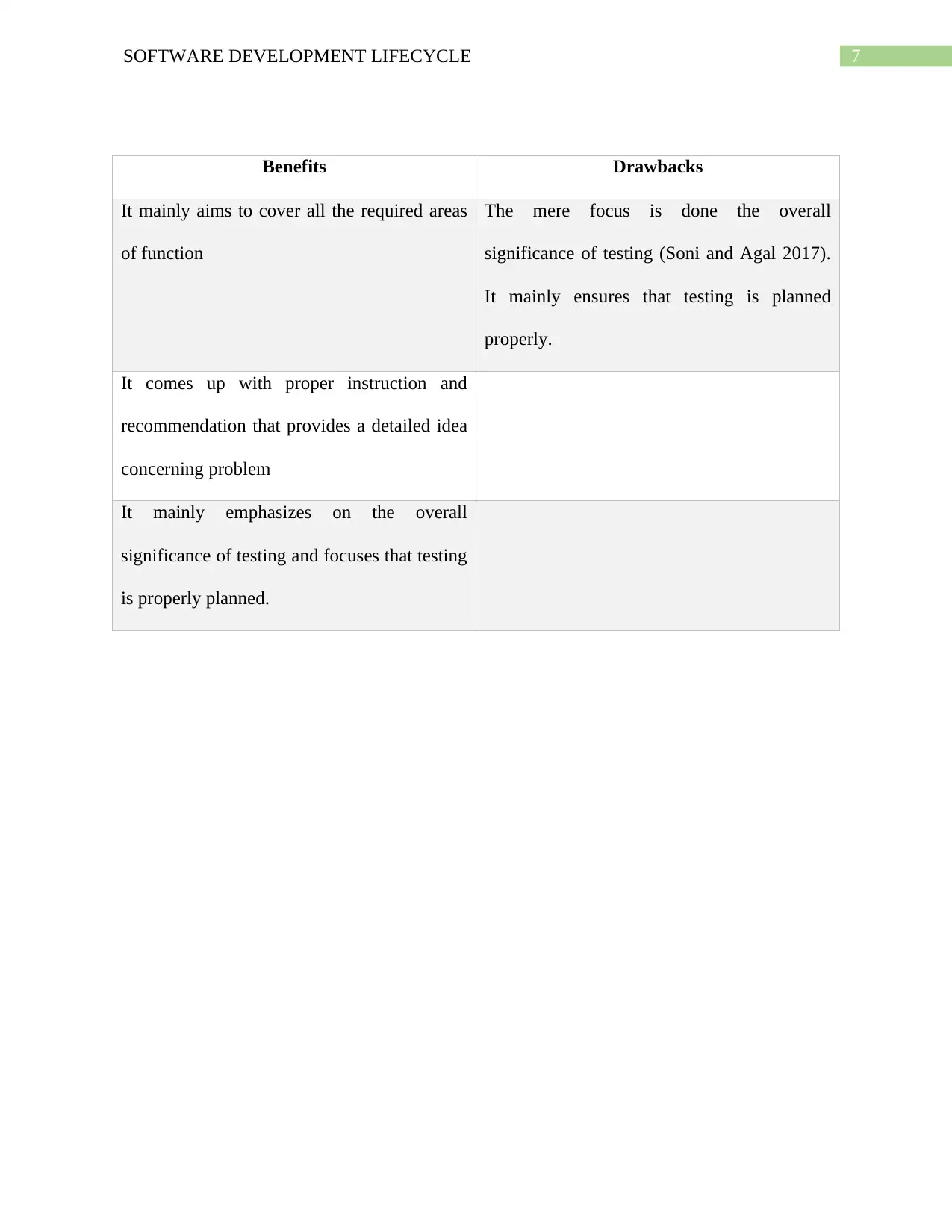
7SOFTWARE DEVELOPMENT LIFECYCLE
Benefits Drawbacks
It mainly aims to cover all the required areas
of function
The mere focus is done the overall
significance of testing (Soni and Agal 2017).
It mainly ensures that testing is planned
properly.
It comes up with proper instruction and
recommendation that provides a detailed idea
concerning problem
It mainly emphasizes on the overall
significance of testing and focuses that testing
is properly planned.
Benefits Drawbacks
It mainly aims to cover all the required areas
of function
The mere focus is done the overall
significance of testing (Soni and Agal 2017).
It mainly ensures that testing is planned
properly.
It comes up with proper instruction and
recommendation that provides a detailed idea
concerning problem
It mainly emphasizes on the overall
significance of testing and focuses that testing
is properly planned.

8SOFTWARE DEVELOPMENT LIFECYCLE
Part 2
Fig 1: Process of Risk Management
(Source: Created by Author)
Inspiral model, proper support is given to software project which can be summarized in
the list of ways
The beginning risk analysis can take as a step and aiming at:
Looking for risk which can bring huge number of threats in the project
It is all about classifying the risk in interface and development of risk
Evaluating risk is very tough to handle each cycle. Classification helps in development in
providing risk resolution based techniques that are benchmarking and prototyping.
Evaluation of prototyping spiral helps in improving the overall performance and user
interface with respect to risk (Aljawarneh, Alawneh and Jaradat 2017). The given spiral
help in reducing the overall risk before proceeding of the whole development process
Part 2
Fig 1: Process of Risk Management
(Source: Created by Author)
Inspiral model, proper support is given to software project which can be summarized in
the list of ways
The beginning risk analysis can take as a step and aiming at:
Looking for risk which can bring huge number of threats in the project
It is all about classifying the risk in interface and development of risk
Evaluating risk is very tough to handle each cycle. Classification helps in development in
providing risk resolution based techniques that are benchmarking and prototyping.
Evaluation of prototyping spiral helps in improving the overall performance and user
interface with respect to risk (Aljawarneh, Alawneh and Jaradat 2017). The given spiral
help in reducing the overall risk before proceeding of the whole development process
⊘ This is a preview!⊘
Do you want full access?
Subscribe today to unlock all pages.

Trusted by 1+ million students worldwide

9SOFTWARE DEVELOPMENT LIFECYCLE
In the stage of risk analysis, each of the cycles aims to precedes in every phase of
waterfall stage:
By the help of resolving development program and interface control that is seen in the
beginning phase of the project.
There is a need for evaluation and resolving of new kind of risk which can come into
picture by making changes in the overall objectives and constraint in the starting phase of
the cycle.
Iterative feature of the spiral model allows the whole development process so that they
can go to the very first quadrant.
The present, constraints and alternatives are about to change, which will make the
alternatives very much attractive.
New kind of technology is mainly incorporated in the development process.
It merely focuses on maximum optimization of the required resource of the project.
It requires to deal with poorly done activities in the beginning phase.
The review is mainly done at the end of the each of cycle with the major stakeholders at
the given decision point so that they avoid the lack of overall commitment of risk atevery
cycle (Rastogi 2015).
Risk concerning complexity of the project is mainly managed by making use of spiral. It
is completely achieved by partitioning activity which is done in the planning phase.
In the stage of risk analysis, each of the cycles aims to precedes in every phase of
waterfall stage:
By the help of resolving development program and interface control that is seen in the
beginning phase of the project.
There is a need for evaluation and resolving of new kind of risk which can come into
picture by making changes in the overall objectives and constraint in the starting phase of
the cycle.
Iterative feature of the spiral model allows the whole development process so that they
can go to the very first quadrant.
The present, constraints and alternatives are about to change, which will make the
alternatives very much attractive.
New kind of technology is mainly incorporated in the development process.
It merely focuses on maximum optimization of the required resource of the project.
It requires to deal with poorly done activities in the beginning phase.
The review is mainly done at the end of the each of cycle with the major stakeholders at
the given decision point so that they avoid the lack of overall commitment of risk atevery
cycle (Rastogi 2015).
Risk concerning complexity of the project is mainly managed by making use of spiral. It
is completely achieved by partitioning activity which is done in the planning phase.
Paraphrase This Document
Need a fresh take? Get an instant paraphrase of this document with our AI Paraphraser
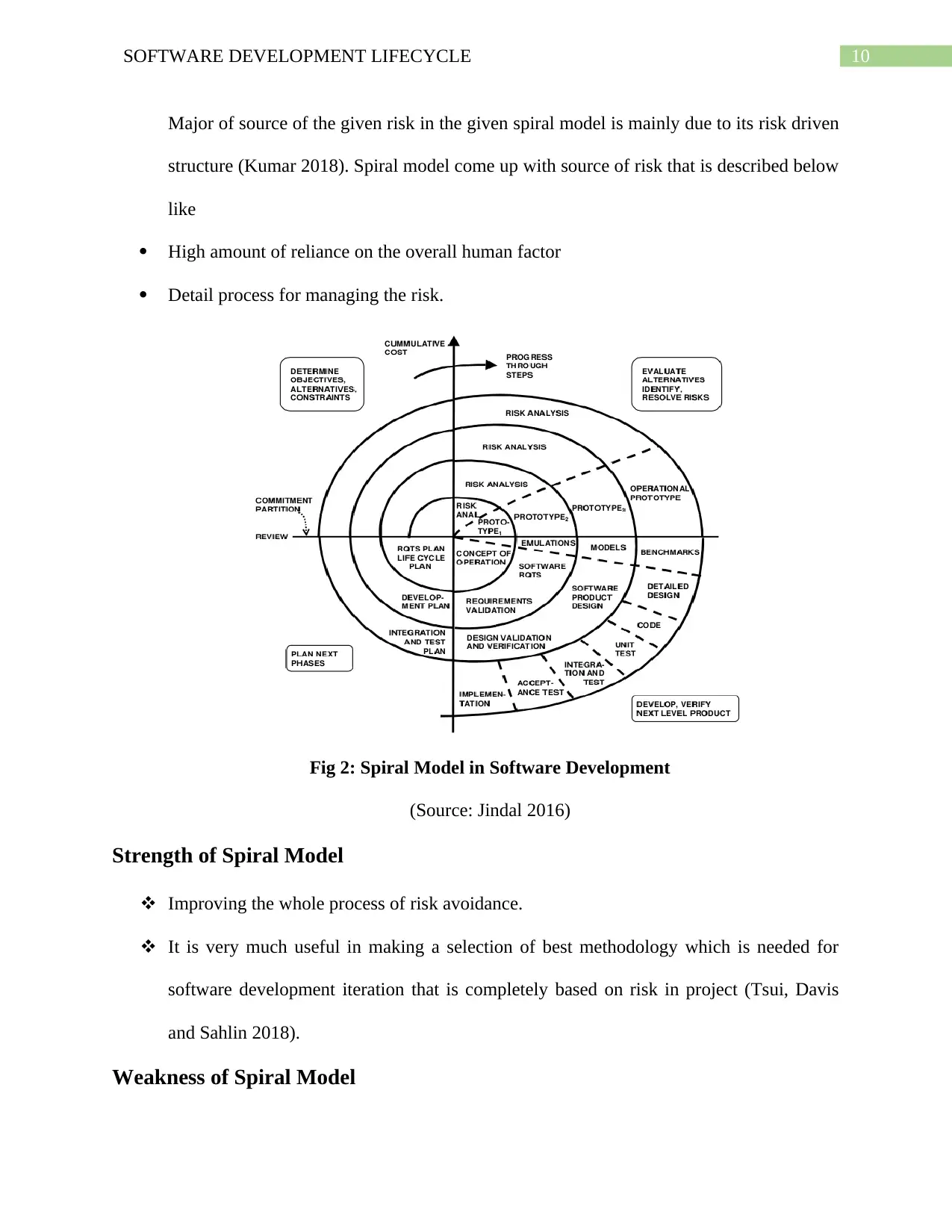
10SOFTWARE DEVELOPMENT LIFECYCLE
Major of source of the given risk in the given spiral model is mainly due to its risk driven
structure (Kumar 2018). Spiral model come up with source of risk that is described below
like
High amount of reliance on the overall human factor
Detail process for managing the risk.
Fig 2: Spiral Model in Software Development
(Source: Jindal 2016)
Strength of Spiral Model
Improving the whole process of risk avoidance.
It is very much useful in making a selection of best methodology which is needed for
software development iteration that is completely based on risk in project (Tsui, Davis
and Sahlin 2018).
Weakness of Spiral Model
Major of source of the given risk in the given spiral model is mainly due to its risk driven
structure (Kumar 2018). Spiral model come up with source of risk that is described below
like
High amount of reliance on the overall human factor
Detail process for managing the risk.
Fig 2: Spiral Model in Software Development
(Source: Jindal 2016)
Strength of Spiral Model
Improving the whole process of risk avoidance.
It is very much useful in making a selection of best methodology which is needed for
software development iteration that is completely based on risk in project (Tsui, Davis
and Sahlin 2018).
Weakness of Spiral Model

11SOFTWARE DEVELOPMENT LIFECYCLE
Issues in analysing the exact position for development methodology is mainly seen in
each of the iterations of the spiral model.
With the help of skilled and experienced project manager, it can become very much easy
for how to apply in the given project.
Situation where it is most suitable
Real time system or critical system
Avoidance of risk which is of high priority.
A high degree of accuracy is considered to be important (Nazir and Nazir 2018).
Situation where minimum right
Avoidance of risk which is of low priority
High degree of essential is not considered to be very much important.
Task 2
In the domain of project life cycle, the feasibility of project is known to be an important
document which is mainly created for the business case (Duits et al. 2016). The main notion of
the study is all about understanding the factors that will help in analysing the business
opportunity, which is provided in this business case.
It is merely inclusive of feasibility study that needs to be explored for some of the major
function of the business opportunity along with alternative path which can be followed
(Nieminen et al. 2016). By the help of data, management aims to make informed decision on the
given path on which it is pursued. It is mainly done so that they can create the best kind of
revenue stream that is needed for the organization.
The feasibility study in the project will help in understanding the various markets where
the target audience is located (Chan et al. 2017). There is a need for alternative target for
Issues in analysing the exact position for development methodology is mainly seen in
each of the iterations of the spiral model.
With the help of skilled and experienced project manager, it can become very much easy
for how to apply in the given project.
Situation where it is most suitable
Real time system or critical system
Avoidance of risk which is of high priority.
A high degree of accuracy is considered to be important (Nazir and Nazir 2018).
Situation where minimum right
Avoidance of risk which is of low priority
High degree of essential is not considered to be very much important.
Task 2
In the domain of project life cycle, the feasibility of project is known to be an important
document which is mainly created for the business case (Duits et al. 2016). The main notion of
the study is all about understanding the factors that will help in analysing the business
opportunity, which is provided in this business case.
It is merely inclusive of feasibility study that needs to be explored for some of the major
function of the business opportunity along with alternative path which can be followed
(Nieminen et al. 2016). By the help of data, management aims to make informed decision on the
given path on which it is pursued. It is mainly done so that they can create the best kind of
revenue stream that is needed for the organization.
The feasibility study in the project will help in understanding the various markets where
the target audience is located (Chan et al. 2017). There is a need for alternative target for
⊘ This is a preview!⊘
Do you want full access?
Subscribe today to unlock all pages.

Trusted by 1+ million students worldwide
1 out of 18
Related Documents
Your All-in-One AI-Powered Toolkit for Academic Success.
+13062052269
info@desklib.com
Available 24*7 on WhatsApp / Email
![[object Object]](/_next/static/media/star-bottom.7253800d.svg)
Unlock your academic potential
Copyright © 2020–2025 A2Z Services. All Rights Reserved. Developed and managed by ZUCOL.



